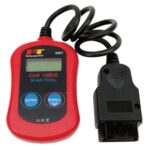Maintaining your 2003 Subaru Forester in top condition often involves routine maintenance, and battery replacement is a common task. However, disconnecting your car battery can lead to more than just a reset clock. Modern vehicles, including the 2003 Subaru Forester, rely on constant power to retain crucial settings and learned data within their control modules. Losing this memory can affect engine performance, radio presets, and other personalized configurations.
Understanding the need to preserve these settings is key, and thankfully, your Subaru Forester offers a solution through its OBDII (On-Board Diagnostics II) connector. While some vehicles allow for power maintenance via the accessory outlet, Subaru Foresters, specifically the 2003 model, do not provide constant power to these outlets. This means another method is needed to keep your system powered during a battery swap.
The OBDII connector, specifically pin 16, is a valuable point in your 2003 Subaru Forester’s electrical system because it’s designed to be always powered. This constant power feed is typically used by diagnostic tools, but it can also be cleverly utilized to maintain system power when you disconnect the main battery.
Many automotive service professionals employ specialized adapters that connect a 12V power source, like a jump starter, to the OBDII connector. This setup, often incorporating a 7.5 Amp fuse for safety, effectively feeds power to the car’s essential systems, preventing memory loss.
Using the OBDII connector to maintain power during a battery change in your 2003 Subaru Forester is generally safe, provided you take precautions. It’s crucial to ensure that no unnecessary electrical loads are active in the car while the battery is disconnected and power is supplied through the OBDII port. Even seemingly minor loads, such as interior lights activated when a door is opened, can draw significant current. If this current draw exceeds the 7.5 Amp fuse’s capacity, the fuse will blow, interrupting the power supply and defeating the purpose of using the OBDII connector in the first place. This blown fuse, while preventing memory saving, does not typically trigger a Check Engine Light (CEL) or other diagnostic codes. However, it will prevent OBDII scanners that rely on vehicle power from functioning until the fuse is replaced and battery is reconnected.
A common sign that the fuse has blown, or that power maintenance was unsuccessful, is a reset clock and radio. In some instances, you might also experience rough idling after reconnecting the battery. This roughness is usually temporary as the engine control module (ECM) quickly “relearns” optimal settings.
Therefore, when replacing the battery in your 2003 Subaru Forester, consider the OBDII connector as a practical solution to preserve your car’s memory. Just remember to be mindful of electrical loads and the 7.5 Amp fuse to ensure a smooth and memory-saving battery replacement process.


